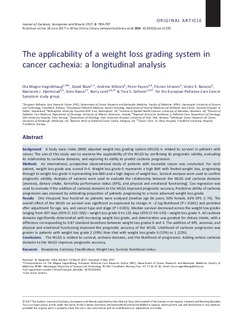| dc.contributor.author | Vagnildhaug, Ola Magne | |
| dc.contributor.author | Blum, David | |
| dc.contributor.author | Wilcock, Andrew | |
| dc.contributor.author | Fayers, Peter | |
| dc.contributor.author | Strasser, Florian | |
| dc.contributor.author | Baracos, Vickie E. | |
| dc.contributor.author | Hjermstad, Marianne Jensen | |
| dc.contributor.author | Kaasa, Stein | |
| dc.contributor.author | Laird, Barry J | |
| dc.contributor.author | Solheim, Tora Skeidsvoll | |
| dc.date.accessioned | 2017-11-16T07:54:26Z | |
| dc.date.available | 2017-11-16T07:54:26Z | |
| dc.date.created | 2017-11-15T13:24:00Z | |
| dc.date.issued | 2017 | |
| dc.identifier.citation | Journal of Cachexia, Sarcopenia and Muscle. 2017, 8 (5), 789-797. | nb_NO |
| dc.identifier.issn | 2190-5991 | |
| dc.identifier.uri | http://hdl.handle.net/11250/2466546 | |
| dc.description.abstract | Background A body mass index (BMI) adjusted weight loss grading system (WLGS) is related to survival in patients with cancer. The aim of this study was to examine the applicability of the WLGS by confirming its prognostic validity, evaluating its relationship to cachexia domains, and exploring its ability to predict cachexia progression. Methods An international, prospective observational study of patients with incurable cancer was conducted. For each patient, weight loss grade was scored 0–4. Weight loss grade 0 represents a high BMI with limited weight loss, progressing through to weight loss grade 4 representing low BMI and a high degree of weight loss. Survival analyses were used to confirm prognostic validity. Analyses of variance were used to evaluate the relationship between the WLGS and cachexia domains [anorexia, dietary intake, Karnofsky performance status (KPS), and physical and emotional functioning]. Cox regression was used to evaluate if the addition of cachexia domains to the WLGS improved prognostic accuracy. Predictive ability of cachexia progression was assessed by estimating proportion of patients progressing to a more advanced weight loss grade. Results One thousand four hundred six patients were analysed (median age 66 years; 50% female, 63% KPS ≤ 70). The overall effect of the WLGS on survival was significant as expressed by change in −2 log likelihood (P < 0.001) and persisted after adjustment for age, sex, and cancer type and stage (P < 0.001). Median survival decreased across the weight loss grades ranging from 407 days (95% CI 312–502)—weight loss grade 0 to 119 days (95% CI 93–145)—weight loss grade 4. All cachexia domains significantly deteriorated with increasing weight loss grade, and deterioration was greatest for dietary intake, with a difference corresponding to 0.87 standard deviations between weight loss grades 0 and 4. The addition of KPS, anorexia, and physical and emotional functioning improved the prognostic accuracy of the WLGS. Likelihood of cachexia progression was greater in patients with weight loss grade 2 (39%) than that with weight loss grade 0 (19%) or 1 (22%). Conclusions The WLGS is related to survival, cachexia domains, and the likelihood of progression. Adding certain cachexia domains to the WLGS improves prognostic accuracy. | nb_NO |
| dc.language.iso | eng | nb_NO |
| dc.publisher | Wiley Open Access | nb_NO |
| dc.relation.uri | http://onlinelibrary.wiley.com/doi/10.1002/jcsm.12220/full | |
| dc.rights | Attribution-NonCommercial-NoDerivatives 4.0 Internasjonal | * |
| dc.rights.uri | http://creativecommons.org/licenses/by-nc-nd/4.0/deed.no | * |
| dc.title | The applicability of a weight loss grading system in cancer cachexia: a longitudinal analysis | nb_NO |
| dc.type | Journal article | nb_NO |
| dc.type | Peer reviewed | nb_NO |
| dc.description.version | publishedVersion | nb_NO |
| dc.source.pagenumber | 789-797 | nb_NO |
| dc.source.volume | 8 | nb_NO |
| dc.source.journal | Journal of Cachexia, Sarcopenia and Muscle | nb_NO |
| dc.source.issue | 5 | nb_NO |
| dc.identifier.doi | 10.1002/jcsm.12220 | |
| dc.identifier.cristin | 1514407 | |
| dc.relation.project | Samarbeidsorganet mellom Helse Midt-Norge og NTNU: 90062500 | nb_NO |
| dc.description.localcode | © 2017 The Authors. Journal of Cachexia, Sarcopenia and Muscle published by John Wiley & Sons Ltd on behalf of the Society on Sarcopenia, Cachexia and Wasting Disorders. This is an open access article under the terms of the Creative Commons Attribution‐NonCommercial‐NoDerivs License, which permits use and distribution in any medium, provided the original work is properly cited, the use is non‐commercial and no modifications or adaptations are made | nb_NO |
| cristin.unitcode | 194,65,15,0 | |
| cristin.unitname | Institutt for klinisk og molekylær medisin | |
| cristin.ispublished | true | |
| cristin.fulltext | original | |
| cristin.qualitycode | 1 | |

